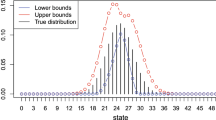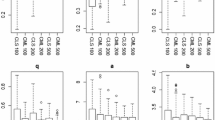Abstract
This paper introduces a new bivariate autoregressive model with random coefficients for the time series of counts. It is composed of two components, the survival and the innovation component. The dependence between two series that comprise the bivariate model stems from both of these components. The introduced model is achieved by defining a bilinear model and the existence of a unique strict stationarity of it is proved. The method of moments is examined for parameters estimation. The practical aspect of the model is discussed by using a real-life data example.




Similar content being viewed by others
References
Al-Osh MA, Aly AAE (1992) First order autoregressive time series with negative binomial and geometric marginals. Commun Stat 21:2483–2492
Al-Osh MA, Alzaid AA (1987) First-order integer-valued autoregressive (INAR(1)) process. J Time Ser Anal 8:261–275
Doukhan P, Latour A, Oraichi D (2006) Simple integer-valued bilinear time series model. Adv Appl Probab 38:559–578
Drost FC, Van den Akker R, Werker BJ (2008) Note on integer-valued bilinear time series models. Stat Probab Lett 78:992–996
Du JG, Li Y (1991) The integer-valued autoregressive (INAR(\(p\))) model. J Time Ser Anal 12:129–142
Feng H, Peng L, Zhu F (2013) Interval estimation for a simple bilinear model. Stat Probab Lett 83:2152–2159
Franke J, Rao TS (1993) Multivariate first-order integer-valued autoregressions. Technical Report, Mathematics Department, UMIST
Granger CW, Andersen AP (1978) An introduction to bilinear time series models. Vandenhoeck and Ruprecht, Gottingen
Jayakumar KDA, Mundassery DA (2007) On bivariate geometric distribution. Stat LXVI I(4):389–404
Kim HY, Park Y (2008) A non-stationary integer-valued autoregressive model. Stat Pap 49:485–502
Kristensen D (2009) On stationarity and ergodicity of the bilinear model with applications to GARCH models. J Time Ser Anal 30:125–144
Latour A (1997) The multivatiate GINAR(\(p\)) process. Adv Appl Probab 29:228–248
Li WK (1984) On the autocorrelation structure and identification of some bilinear time series. J Time Ser Anal 5:173–181
Ling S, Peng L, Zhu F (2015) Inference for a special bilinear time-series model. J Time Ser Anal 36:61–66
Nastić AS, Laketa PN, Ristić MM (2016) Random environment integer-valued autoregressive process. J Time Ser Anal 37:267–287
Pedeli X, Karlis D (2011) A bivariate INAR(1) process with application. Stat Model 11:325–349
Pedeli X, Karlis D (2013) On estimation of the bivariate Poisson INAR process. Commun Stat 42:514–533
Pedeli X, Karlis D (2013) Some properties of multivariate INAR(1) processes. Comput Stat Data Anal 67:213–225
Popović PM (2015) Random coefficient bivariate INAR(1) process. Facta Univ Ser 30:263–280
Popović PM, Ristić MM, Nastić AS (2016) A geometric bivariate time series with different marginal parameters. Stat Pap 57:731–753
Quinn BG (1982) Stationarity and invertibility of simple bilinear models. Stoch Process Appl 12:225–230
Rao ST (1981) On the theory of bilinear time series models. J R Stat Soc Ser B (Methodol) 43:244–255
Ristić MM, Bakouch HS, Nastić AS (2009) A New geometric first-order integervalued autoregressive (NGINAR(1)) process. J Stat Plann Inference 139:2218–2226
Ristić MM, Nastić AS, Jayakumar K, Bakouch HS (2012) A bivariate INAR(1) time series model with geometric marginals. Appl Math Lett 25:481–485
Scotto MG, Weiss CH, Silva ME, Pereira I (2014) Bivariate binomial autoregressive models. J Multivar Anal 125:233–251
Scotto MG, Weiss CH, Gouveia S (2015) Thinning-based models in the analysis of integer-valued time series: a review. Stat Model 15:590–618
Steutel FW, van Harn K (1979) Discrete analogues of self-decomposability and stability. Ann Probab 7:893–899
Acknowledgements
The authors are very grateful to the associate editor and the three referees for suggestions and comments that greatly improved this paper.
Author information
Authors and Affiliations
Corresponding author
Appendix
Appendix
Proof of Theorem 1
Proof
Let us define a random sequence \(\big \{\varvec{Z}_t^{(n)}=(X_{1,t}^{(n)}, X_{2,t}^{(n)})'\big \}\) such that
where n is the index of the sequence element and \(\varvec{A}_{(t)}\) means that the counting series which defines the binomial thinning operator is fixed at time t, i.e. at time t, when n tends to infinity, the counting series remains unchanged. Also, similarly as in Popović et al. (2016), define the Hilbert space \(L^2(\Omega , \mathcal {F}, P)=\{\varvec{Z}:E(\varvec{Z}\varvec{Z}')<\infty \}\), where the measure between two random variables \(\varvec{Y}\) and \(\varvec{W}\) is defined as \(E(\varvec{Y}\varvec{W}')\). The idea is to prove that the sequence \(\{\varvec{Z}_t^{(n)}\}\) is strictly stationary and that it converges in probability to the solution of Eq. (3).
The first step is to show that the sequence \(\{\varvec{Z}_t^{(n)}\}\) is non-decreasing. From the definition of the sequence, we have
Following the induction hypotheses, we have that \(\varvec{Z}_{t-1}^{(k-1)}\le \varvec{Z}_{t-1}^{(k)}\), which implies that
Thus, we have \(\varvec{Z}_{t}^{(k)}\le \varvec{Z}_{t}^{(k+1)}\). By induction, we can conclude that the sequence \(\{\varvec{Z}_t^{(n)}\}\) is non-decreasing.
The proof of the strict stationarity of the sequence \(\{\varvec{Z}_t^{(n)}\}\) is similar to the one in Doukhan et al. (2006) so we will omit it here.
Now, let us focus on the convergence of the sequence \(\{\varvec{Z}_t^{(n)}\}\) in the defined Hilbert space. Having in mind strict stationarity, we have that \(\varvec{Z}_t^{(n)}-\varvec{Z}_{t}^{(n-1)}{\mathop {=}\limits ^{d}}\varvec{A}_{(t)}\circ (\varvec{B}_{t-1}(\varvec{Z}_{t-1}^{(n-1)}-\varvec{Z}_{t-1}^{(n-2)}))\). Taking the expectation of both sides, we obtain
The right side converges to zero matrix as n tends to infinity if and only if \(\alpha _jp_j\lambda _j<1\), \(j=1,2\). Note that if we define a random array \(\varvec{z}_n=E(\varvec{Z}_t^{(n)}-\varvec{Z}_{t}^{(n-1)})\), then we have
Thus, when \(\alpha _jp_j\lambda _j<1\), \(j=1,2\), the series \(\sum _{n=1}^{\infty }\varvec{z}_n\) is convergent.
Since the sequence \(\{\varvec{Z}_t^{(n)}\}\) is non-negative and non-decreasing, we should prove that the limit of such sequence is almost surely finite. By using a similar approach as in Doukhan et al. (2006), we define sets \(B_{\infty }=\{\omega : \varvec{Z}_t(\omega )=\infty \}\) and \(B_{n}=\{\omega : \varvec{Z}_t^{(n)}(\omega )-\varvec{Z}_t^{(n-1)}(\omega )>\varvec{0}\}\). Then, \(B_{\infty }=\{\omega : \varvec{Z}_t(\omega )=\infty \}=\underset{n\rightarrow \infty }{\limsup }B_n\). Also, we have that
Having in mind previous results, we can conclude that the series \(\sum _{n=1}^{\infty }P(B_n)\) is convergent when \(\alpha _jp_j\lambda _j<1\), \(j=1,2\). A direct implication of the Borel–Cantelli lemma is that \(\underset{n\rightarrow \infty }{\limsup }B_n=0\), i.e. \(P(B_{\infty })=0\). Since the sequence \(\{\varvec{Z}_t^{(n)}\}\) is strictly stationary, then its almost sure limit \(\varvec{Z}_t\) is strictly stationary as well.
The uniqueness of the solution of Eq. (3) can be proved by using the same technique as in Doukhan et al. (2006). \(\square \)
Rights and permissions
About this article
Cite this article
Popović, P.M., Bakouch, H.S. A bivariate integer-valued bilinear autoregressive model with random coefficients. Stat Papers 61, 1819–1840 (2020). https://doi.org/10.1007/s00362-018-1005-1
Received:
Revised:
Published:
Issue Date:
DOI: https://doi.org/10.1007/s00362-018-1005-1




